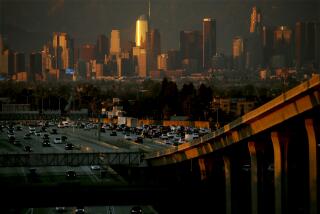Assembly OKs bill allowing clean-air autos in car-pool lanes
A bill that would prevent local transit agencies from tossing solo drivers in zero- and low-emission vehicles out of some car-pool lanes cleared the California Assembly on Thursday.
The legislation, authored by Assemblyman Bob Blumenfield (D-Woodland Hills), would allow cars with a Clean Air Vehicle Sticker free access to carpool lanes that are converted to High Occupancy Toll lanes.
There are a number of such projects around the state and agencies such as the Metropolitan Transportation Authority plan to make any solo drivers pay for access, regardless of what they are driving. Car-poolers and buses will still be able to use the lanes without charge.
In Southern California, transit officials are converting 25 miles of carpool lanes on the 10 and 110 freeways into such toll lanes. Solo drivers will have to pay up to $1.40 a mile during peak rush-hour traffic.
As part of a one-year and pilot program, the MTA plans to start charging tolls for solo drivers using a section of the 110 Freeway between Adams Boulevard and the Artesia Transit Center in October and the 10 Freeway between Alameda Street and the 605 Freeway in February.
“The clean-car sticker program has been a tremendous success in keeping our air cleaner and reducing climate change,” said Blumenfield. “But we will soon see many carpool lanes converted into toll lanes. My bill preserves a key incentive for consumers to continue to purchase cleaner, greener cars.”
Vehicles eligible for the stickers include electric cars, plug-in hybrids as well as natural gas and hydrogen-powered autos.
Blumenfied’s legislation, AB 2405, passed the Assembly on a 49-25 vote and moves to the state Senate for consideration.
The MTA has said it wants to keep traffic moving by charging all solo drivers for using the roads. The agency said the prior experiments allowing solo drivers in so-called clean vehicles have clogged traffic more than many people realize.
When conventional hybrids and alternative-fuel vehicles were allowed onto the southbound 110 during afternoon rush hour two years ago, they accounted for almost 1 in 5 vehicles in the carpool lane, according to the MTA.
RELATED:Ford brings electric car cost into focus
War veterans more likely to crash cars
Female drivers more likely to hit wrong pedal







